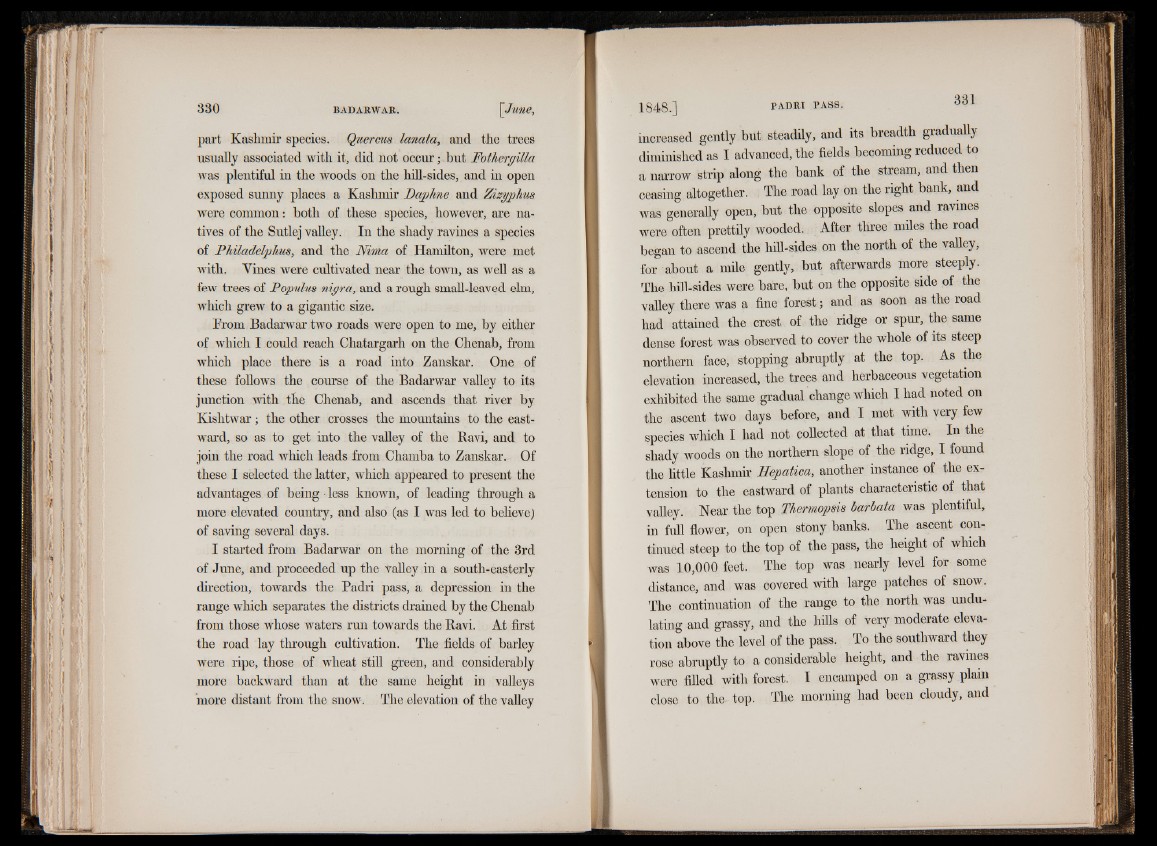
paxt Kashmir species. Quercus lanata, and the trees
usually associated with it, did not occur; but Fothergitta
was plentiful in the woods on the hill-sides, and in open
exposed sunny places a Kashmir Daphne and Zizgphus
were common: both of these species, however, are natives
of the Sutlej valley. In the shady ravines a species
of Philadelphus, and the Nima of Hamilton, were met
with. Vines were cultivated near the town, as well as a
few trees of Populus nigra, and a rough small-leaved elm,
which grew to a gigantic size.
Erom Badarwar two roads were open to me, by either
of which I could reach Chatargarh on the Chenab, from
which place there is a road into Zanskar. One of
these follows the course of the Badarwar valley to its
junction with the Chenab, and ascends that river by
Kishtwar; the other crosses the mountains to the eastward,
so as to get into the valley of the Ravi, and to
join the road which leads from Chamba to Zanskar. Of
these I selected the latter, which appeared to present the
advantages of being • less known, of leading through a
more elevated country, and also (as I was led to believe)
of saving several days.
I started from Badarwar on the morning of the 3rd
of June, and proceeded up the Valley in a south-easterly
direction, towards the Padri pass, a depression in the
range which separates the districts drained by the Chenab
from those whose waters run towards the Ravi. At first
the road lay through cultivation. The fields of barley
were ripe, those of wheat still green, and considerably
more backward than at the same height in valleys
more distant from the snow. The elevation of the valley
increased gently but steadily, and its breadth gradually
diminished as I advanced, the fields becoming reduced to
a narrow strip along the bank of the stream, and then
ceasing altogether. The road lay on the right bank, and
was generally open, but the opposite slopes and ravines
were often prettily wooded. After three miles the road
began to ascend the hill-sides on the north of the valley,
for about a mile gently, but afterwards more steeply.
The hill-sides were bare, but on the opposite side of the
valley there was a fine forest % and as soon as the road
had attained the crest of the ridge or spur, the same
dense forest was observed to cover the whole of its steep
northern face, stopping abruptly at the top. As the
elevation increased, the trees and herbaceous vegetation
exhibited the same gradual change which I had noted on
the ascent two days before, and I met with very few
species which I had not collected at that time. In the
shady woods on the northern slope of the ridge, I found
the little Kashmir Hepatica, another instance of the extension
to the eastward of plants characteristic of that
valley. Near the top Thermopsis barhata was plentiful,
in full flower, on open stony banks. The ascent continued
steep to the top of the pass, the height of which
was 10,000 feet. The top was nearly level for some
distance, and was covered with large patches of snow.
The continuation of the range to the north was undulating
and grassy, and the hills of very moderate elevation
above the level of the pass. To the southward they
rose abruptly to a considerable height, and the ravines
were filled with forest. I encamped on a grassy plain
close to the top. The morning had been cloudy, and